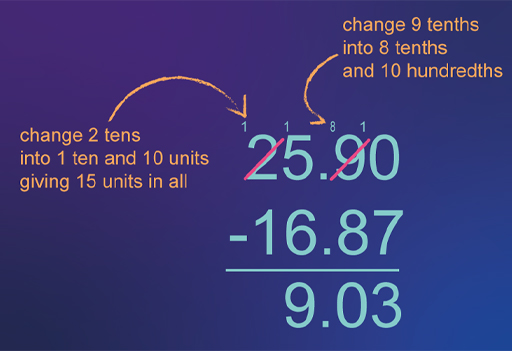5.1 Subtracting one number from another
As with addition, you may feel comfortable already with how to perform subtraction on paper. You may have also learned a different method to the one shown here and if this works for you it’s fine to continue with your method. Here’s a quick overview in case you feel that you need a reminder.
Write out the calculation so that the decimal points and the corresponding columns line up, making sure the number you are subtracting is on the bottom. Then, subtract the bottom number from the top number in each column, starting from the right. Remember, if you need to borrow from the next column, you need to change the value in that column. Figure 15 below describes how you can do this. You will only need to do this if you don’t have enough in one column to perform the subtraction.
Now it’s time to put your knowledge to use in an activity using addition and subtraction when dealing with the slightly trickier situation of time.
Activity 4 Time, addition and subtraction
Imagine you are travelling by train to attend a very important meeting. The train is leaving at 9:35 a.m. and arriving at 11:10 a.m. The ticket costs £48.30 but you have a refund voucher for £15.75, following the cancellation of a train on an earlier journey. How long will the journey take, and how much money will you have to pay for the ticket if you use the entire refund voucher?
Remember, if you need a hint, click on ‘Reveal comment’.
Comment
Start by taking out and listing all the information from the question – this should help to make the problem clearer.
Solution
Answer
Working with times can be tricky because you have to remember that there are 60 minutes in an hour, so you are not working with the simple decimal system based on the number 10. One way to do this is by imagining a clock and saying, ‘From 9:35 a.m. to 10:00 a.m. is 25 minutes; 10:00 a.m. to 11:00 a.m. is an hour and 11:00 a.m. to 11:10 a.m. is an extra ten minutes. So the journey time is 1 hour and 35 minutes, assuming the train runs on time.’
Now you have one more step. To find out how much you will have to pay for the ticket, you need to subtract £15.75 from £48.30. There are different ways of doing this; one way is to work up from £15.75, adding on 25 pence to give you £16.00, then £32.00 to get to £48.00 and finally another 30 pence to reach £48.30. The total to pay is £32.00 plus 25 pence plus 30 pence or £32.55.
Now it’s time to investigate the two other operations: multiplication and division, starting with multiplication.

